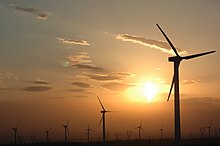Main article: Geography of the People's Republic of China
See also: Geography of Taiwan
The Li River in Guangxi.
Political geography
The People's Republic of China is the second-largest country in the world by land area after Russia[13] and is either the third- or fourth-largest by total area, after Russia, Canada and, depending on the definition of total area, the United States.[84] China's total area is generally stated as being approximately 9,600,000 km2 (3,700,000 sq mi).[85] Specific area figures range from 9,572,900 km2 (3,696,100 sq mi) according to the Encyclopædia Britannica,[86] 9,596,961 km2 (3,705,407 sq mi) according to the UN Demographic Yearbook,[87] to 9,596,961 km2 (3,705,407 sq mi) according to the CIA World Factbook,[88] and 9,640,011 km2 (3,722,029 sq mi) including Aksai Chin and the Trans-Karakoram Tract, which are controlled by China and claimed by India.[89] None of these figures include the 1,000 square kilometres (386.1 sq mi) of territory ceded to China by Tajikistan following the ratification of a Sino-Tajik border agreement in January 2011.[90]According to the Encyclopædia Britannica, the total area of the United States, at 9,522,055 km2 (3,676,486 sq mi), is slightly smaller than that of China. Meanwhile, the CIA World Factbook states that China's total area was greater than that of the United States until the coastal waters of the Great Lakes was added to the United States' total area in 1996.[91]
China has the longest combined land border in the world, measuring 22,117 km (13,743 mi) from the mouth of the Yalu River to the Gulf of Tonkin. China borders 14 nations, more than any other country except Russia, which also borders 14. China extends across much of East Asia, bordering Vietnam, Laos, and Burma in Southeast Asia; India, Bhutan, Nepal and Pakistan[92] in South Asia; Afghanistan, Tajikistan, Kyrgyzstan and Kazakhstan in Central Asia; a small section of Russian Altai and Mongolia in Inner Asia; and the Russian Far East and North Korea in Northeast Asia.
Additionally, China shares maritime boundaries with South Korea, Japan, Vietnam and the Philippines. The PRC and the Republic of China (Taiwan) make mutual claims over each other's territory and the frontier between areas under their respective control is closest near the islands of Kinmen and Matsu, off the Fujian coast, but otherwise run through the Taiwan Strait. The PRC and ROC assert identical claims over the entirety of the Spratly Islands in the South China Sea, and the southern-most extent of these claims reach Zengmu Ansha (James Shoal), which would form a maritime frontier with Malaysia.
Landscape and climate
A major environmental issue in China is the continued expansion of its deserts, particularly the Gobi Desert, which is currently the world's fifth-largest desert.[93][94] Although barrier tree lines planted since the 1970s have reduced the frequency of sandstorms, prolonged drought and poor agricultural practices have resulted in dust storms plaguing northern China each spring, which then spread to other parts of East Asia, including Korea and Japan. According to China's environmental watchdog, Sepa, China is losing a million acres (4,000 km²) per year to desertification.[95] Water quality, erosion, and pollution control have become important issues in China's relations with other countries. Melting glaciers in the Himalayas could potentially lead to water shortages for hundreds of millions of people.[96]
China's climate is mainly dominated by dry seasons and wet monsoons, which lead to a pronounced temperature differences between winter and summer. In the winter, northern winds coming from high-latitude areas are cold and dry; in summer, southern winds from coastal areas at lower latitudes are warm and moist. The climate in China differs from region to region because of the country's extensive and complex topography.
Biodiversity
Main article: Wildlife of China
China also hosts a variety of forest types. Cold coniferous forests predominate in the north of the country, supporting animal species such as moose and the Asian black bear, along with over 120 bird species. Moist conifer forests can have thickets of bamboo as an understorey, replaced by rhododendrons in higher montane stands of juniper and yew. Subtropical forests, which dominate central and southern China, support as many as 146,000 species of flora. Tropical and seasonal rainforests, though confined to Yunnan and Hainan Island, contain a quarter of all the plant and animal species found in China.
Environmental issues
Main article: Environment in the People's Republic of China
Environmental campaigners such as Ma Jun have warned of the danger that water pollution poses to Chinese society.[99] According to the Chinese Ministry of Water Resources, roughly 300 million Chinese do not have access to safe drinking water, and 40% of China’s rivers have been polluted by industrial and agricultural waste as of late 2011.[100] This crisis is compounded by the perennial problem of water shortages, with 400 out of 600 surveyed Chinese cities reportedly short of drinking water.[101][102]
However, China is the world's leading investor in renewable energy technologies, with $34.6 billion invested in 2009 alone.[103][104] China produces more wind turbines and solar panels than any other country,[105] and renewable energy projects, such as solar water heating, are widely pursued at the local level.[106] By 2009, over 17% of China's energy was derived from renewable sources – most notably hydroelectric power plants, of which China has a total installed capacity of 197 GW.[107] In 2011, the Chinese government announced plans to invest four trillion yuan (US$618.55 billion) in water infrastructure projects over a ten-year period, and to complete construction of a flood prevention and anti-drought system by 2020.[108]



















0 comments:
Post a Comment